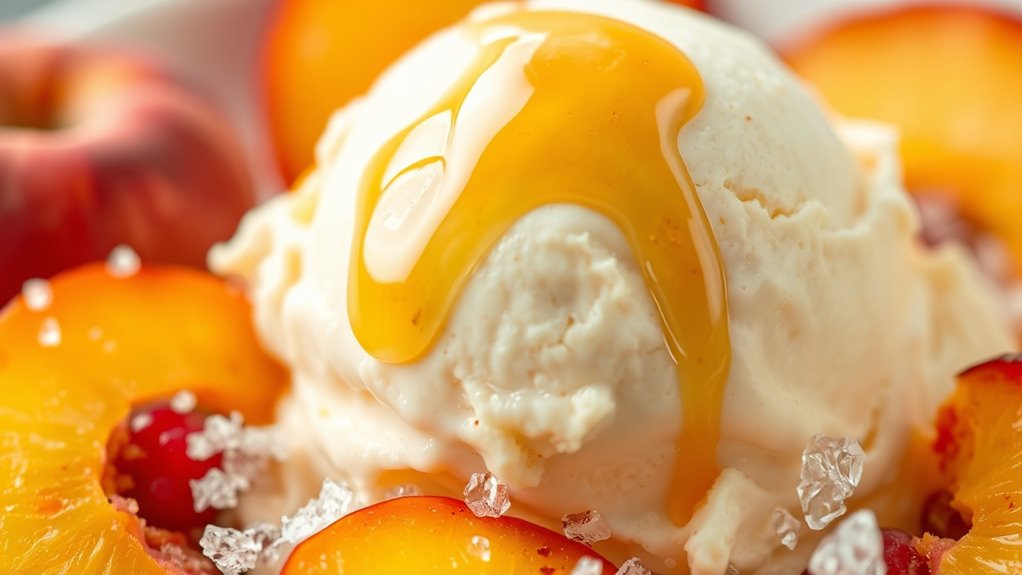Using alternative sugars like invert sugar, fructose, and xylitol in ice cream helps you enjoy sweet treats with fewer calories and a lower glycemic impact. Invert sugar improves texture and prevents crystallization, while fructose adds natural sweetness with less energy contribution, though it should be consumed in moderation. Xylitol offers a lower blood sugar response and dental benefits, but too much can upset your stomach. Keep exploring to discover how these sugars can fit into your favorite frozen indulgences.
Key Takeaways
- Invert sugar, composed of glucose and fructose, improves ice cream texture and prevents crystallization but can impact blood sugar levels.
- Fructose, naturally found in fruits, provides sweetness with fewer calories but should be consumed in moderation due to metabolic risks.
- Xylitol, a sugar alcohol from plant fibers, offers lower calories and a low glycemic index, benefiting diabetics and oral health.
- All three sugars vary in their effects on blood glucose and digestion, requiring mindful use in health-conscious ice cream formulations.
- Choosing alternative sugars balances sweetness, health benefits, and potential risks, catering to consumers seeking lower-calorie options.

Alternative sugars are becoming popular choices for those looking to reduce calorie intake or manage blood sugar levels. When you opt for these sweeteners, you often aim to enjoy the natural sweetness without the typical health concerns associated with regular sugar. In the context of ice cream, this means you can indulge in your favorite treats while potentially benefiting from lower calories and a more stable blood sugar response. But it’s essential to understand the differences between these sugars and their health implications to make informed decisions.
Invert sugar, for example, is a mixture of glucose and fructose created by splitting sucrose. It’s prized in ice cream for its ability to enhance smoothness and prevent crystallization, giving your dessert a soft, creamy texture. While invert sugar is derived from natural sources like sugarcane or beets, it’s processed, which may influence its health implications. Because it contains fructose and glucose, it can impact blood sugar levels more than some other alternatives, especially if consumed in large amounts. If you’re watching your blood sugar, you might want to use invert sugar sparingly, keeping in mind that it still provides natural sweetness but with some metabolic considerations.
Invert sugar, a glucose and fructose mixture from natural sources, enhances ice cream texture but impacts blood sugar levels.
Fructose, naturally found in fruits and honey, is often used as a sweetener in reduced-calorie ice creams. It’s sweeter than sucrose, so you need less of it to achieve the same level of sweetness. The appeal of fructose lies in its ability to provide natural sweetness with fewer calories, which can help in weight management. However, health implications are a bit complex. Excessive intake of fructose has been linked to insulin resistance, fatty liver, and other metabolic issues. When you choose fructose as an alternative sugar, it’s best to do so in moderation and be mindful of your overall sugar consumption.
Xylitol, a sugar alcohol derived from plant fibers, offers a different profile. It provides a natural sweetness similar to sugar but with fewer calories and a lower glycemic index. This makes it appealing if you’re trying to manage blood sugar levels or reduce calorie intake. Since xylitol isn’t fully absorbed by your body, it results in less impact on blood glucose, which is a significant health benefit for diabetics or those on low-carb diets. Plus, it doesn’t promote tooth decay, adding to its appeal as a natural alternative. Nevertheless, consuming large amounts of xylitol can cause digestive discomfort, so moderation is key. Additionally, some Sweeteners may influence overall health and metabolic responses.
Frequently Asked Questions
Are Alternative Sugars Safe for Children and Diabetics?
You should be cautious with alternative sugars like invert sugar, fructose, and xylitol for children and diabetics. They can impact sugar metabolism differently; for example, fructose may cause insulin spikes, and xylitol can cause digestive issues. While xylitol benefits dental health by reducing cavities, excessive consumption can still pose risks. Always consult a healthcare professional to determine safe amounts, ensuring balanced sugar metabolism and protecting dental health.
How Do Alternative Sugars Impact Ice Cream Shelf Life?
Think of alternative sugars as guardians of your ice cream’s freshness, extending its shelf life like an unbreakable shield. They offer preservation benefits by slowing down crystallization and enhancing microbial stability, which keeps your treat smoother and safer longer. These sugars reduce water activity, preventing spoilage and mold growth. So, by choosing invert sugar, fructose, or xylitol, you’re boosting your ice cream’s durability while delighting in its consistent texture and flavor.
Do Alternative Sugars Alter Ice Cream Texture or Flavor?
Yes, alternative sugars can alter ice cream’s texture and flavor. They often cause texture modification, making the ice cream smoother or creamier, and can also influence sweetness levels, leading to flavor enhancement. You might notice a different mouthfeel or subtle changes in taste. These sugars can help you create unique textures and flavors, but it’s essential to balance them carefully to achieve your desired ice cream quality.
Are There Any Allergies Associated With Alternative Sugars?
Yes, alternative sugars can cause allergenic reactions or digestive issues in some people. For example, xylitol may lead to bloating or diarrhea, especially if consumed in large amounts. Fructose can cause gastrointestinal discomfort for those with fructose intolerance. While true allergies are rare, sensitivities vary, so it’s important to check labels and consult with a healthcare professional if you experience adverse reactions after eating ice cream with alternative sugars.
Can Alternative Sugars Be Used in Homemade Ice Cream Recipes?
You can absolutely use alternative sugars in homemade ice cream, transforming your kitchen into a flavor revolution! Just remember, sugar substitution requires ingredient adjustments to get the perfect texture and sweetness. Invert sugar, fructose, or xylitol can replace traditional sugar, but you might need to tweak quantities or add stabilizers. With a little experimentation, your homemade ice cream will become a luscious, innovative treat bursting with flavor!
Conclusion
By choosing alternative sugars like invert sugar, fructose, and xylitol, you can enjoy creamy ice cream with less guilt. Did you know that using these sweeteners can reduce overall sugar intake by up to 30% without sacrificing flavor? Switching to these options not only satisfies your sweet tooth but also supports healthier choices. So next time you indulge, consider choosing alternative sugars for a tasty, mindful treat that benefits your well-being.










